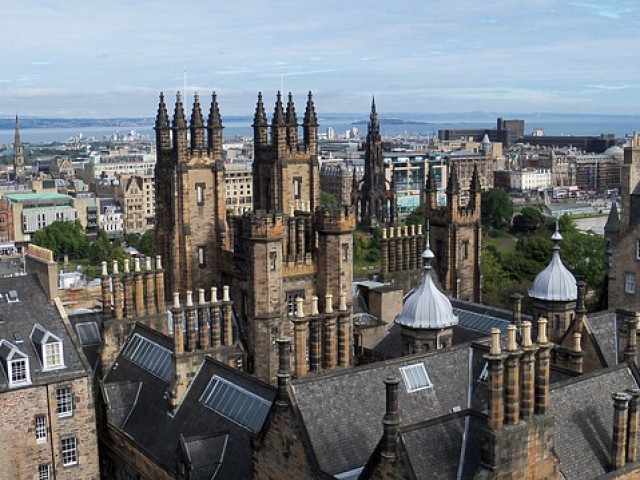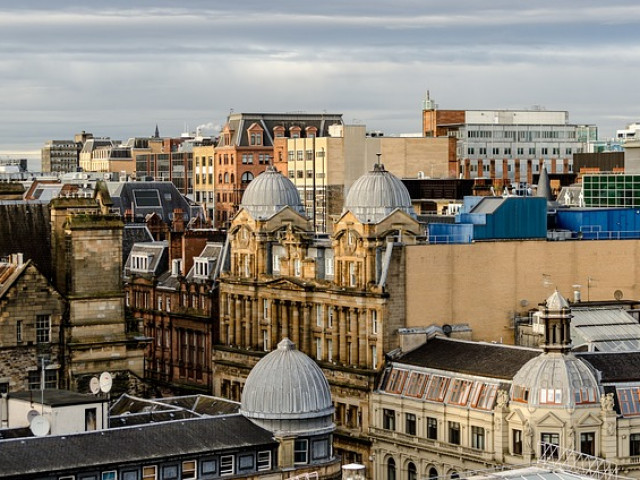Scotland is not just an extension of England - it is a proudly independent country with areas of wild coastland, high moorlands, remote villages, islands and snow-capped mountains. The bigger cities such as Glasgow and Edinburgh are well known for their historical and cultural sights as well as for their vibrant nightlife.
Where to buy tickets for Scotland
The Trainline
Booking Platform
The Trainline is a British digital rail and coach technology platform operating across Europe.
Visit The TrainlineSponsored Link
Omio
Booking Platform
Omio is a German online travel comparison and booking website based in Berlin.
Visit OmioSponsored Link
What to expect from the weather in Scotland
The climate of Scotland is temperate and rarely extreme. The country is warmed by the North Atlantic Drift and because of the northerly location of the country, it experiences rather mild conditions.
Average temperatures are lower compared to the rest of Great Britain, winter maximums are generally around 5 to 7°C, with summer temperatures averaging 15°C. The coastal areas in the west of Scotland are normally warmer than the east and the inland areas.
The western highlands of Scotland are one of the wettest regions in the UK. The annual rainfall there can be up to 4577mm.
European windstorms in autumn and winter are a common feature in Scotland.
Average temperatures are lower compared to the rest of Great Britain, winter maximums are generally around 5 to 7°C, with summer temperatures averaging 15°C. The coastal areas in the west of Scotland are normally warmer than the east and the inland areas.
The western highlands of Scotland are one of the wettest regions in the UK. The annual rainfall there can be up to 4577mm.
European windstorms in autumn and winter are a common feature in Scotland.
Accommodation
In Scotland, you’ll find a full range of accommodation, such as guest houses, bed & breakfasts, hotels, international resort hotels, self-catering, campsites, serviced apartments, lodges, inns and campus accommodation.
Accommodation is rated by VisitScotland, VisitBritain, Visit Wales, the AA and RAC. These have recently agreed on certain standards for accommodation's quality assessment. Accommodation is rated using the international star system of one to five stars.
Accommodation is rated by VisitScotland, VisitBritain, Visit Wales, the AA and RAC. These have recently agreed on certain standards for accommodation's quality assessment. Accommodation is rated using the international star system of one to five stars.
What are the business hours?
Banks are open Monday - Friday 09.30-16.30(some close later and are also open Saturday mornings). Smaller shops are open Monday - Saturday 09.00-17.30, but supermarkets/off license shops are open longer, often until 22.00. Many shops in larger towns and cities are open on Sundays from 11.00 - 16.00
What about travel visas?
EU citizens and nationals of the following countries do not require a visa:
Australia, Canada, USA, Japan, South Africa, American Samoa, Andorra, Antigua & Barbuda, Argentina, Aruba, The Bahamas, Barbados, Belize, Bolivia, Bonaire, Botswana, Brazil, British Overseas Territories, Brunei, Chile, Cook Islands, Costa Rica, Curacao, Dominica, East Timor, El Salvador, Federated States of Micronesia, French Guiana, Greenland, Grenada, Guadeloupe, Guam, Guatemala, Honduras, Hong Kong (SAR), Iceland, Israel, Kiribati, Korea (Rep), Lesotho, Liechtenstein, Macau (SAR), Malawi, Malaysia, Maldives, Marshall Islands, Martinique, Mauritius, Mexico, Monaco, Namibia, Nauru, New Caledonia, New Zealand, Nicaragua, Niue, Norway, Palau, Panama, Papua New Guinea, Paraguay, Puerto Rico, Reunion, Saba, St Eustatius, St Kitts & Nevis, St Lucia, St Maarten, St Vincent & the Grenadines, Samoa, San Marino, Seychelles, Singapore, Solomon Islands, South Africa, Swaziland, Switzerland, Tahiti, Tonga, Trinidad & Tobago, Tuvalu, Uruguay, US Virgin Islands, Vanuatu and Venezuela.
Australia, Canada, USA, Japan, South Africa, American Samoa, Andorra, Antigua & Barbuda, Argentina, Aruba, The Bahamas, Barbados, Belize, Bolivia, Bonaire, Botswana, Brazil, British Overseas Territories, Brunei, Chile, Cook Islands, Costa Rica, Curacao, Dominica, East Timor, El Salvador, Federated States of Micronesia, French Guiana, Greenland, Grenada, Guadeloupe, Guam, Guatemala, Honduras, Hong Kong (SAR), Iceland, Israel, Kiribati, Korea (Rep), Lesotho, Liechtenstein, Macau (SAR), Malawi, Malaysia, Maldives, Marshall Islands, Martinique, Mauritius, Mexico, Monaco, Namibia, Nauru, New Caledonia, New Zealand, Nicaragua, Niue, Norway, Palau, Panama, Papua New Guinea, Paraguay, Puerto Rico, Reunion, Saba, St Eustatius, St Kitts & Nevis, St Lucia, St Maarten, St Vincent & the Grenadines, Samoa, San Marino, Seychelles, Singapore, Solomon Islands, South Africa, Swaziland, Switzerland, Tahiti, Tonga, Trinidad & Tobago, Tuvalu, Uruguay, US Virgin Islands, Vanuatu and Venezuela.
How much should you tip in Scotland?
If you were happy with the service you received, a 10-15% tip is common, especially in restaurants or cafés with table service. Tipping in bars is not really common and not considered necessary. In a cab, you’d normally simply round up the fare to the nearest pound when paying.
| ATM availability | Available |
| Emergency services | Ambulance, police and fire 999/112 |
| Tourist board | http://www.visitscotland.com |
| Famous for | Tartans, whisky, bagpipes, haggis |
| Useful phrases | Scottish Gaelic: Halò (hello), Beannachd leat (goodbye), taphada leat (thank you), Gabh mo leisgeul! (sorry) |
History
Although Scotland became part of Britain after the 1707 Treaty of Union, there has always been a strong sense of national independence and regaining full independence from England has always been the aim of many Scots. In 1999, Scotland did achieve a greater degree of autonomy from the UK Government, when, for the first time in 300 years, it regained its own Parliament. The Scottish Parliament has power over matters such as education, health and some areas of taxation. However, the UK Government is still in control of defence and foreign policy.
Politics
The largest parties are the Scottish National Party, who campaign for full Scottish independence and the Labour party with the Conservatives historically doing less well north of the border. First Minister Alex Salmond (SNP) leads a minority government. Before him, Jack McConnell (Labour) was First Minister; the government was then formed on a coalition basis with the Liberal Democrats. Other parties that are currently represented in the parliament are the Conservative and the Unionist Party and the Scottish Greens.
The main political debate in Scotland revolves around the constitutional question. Now the main argument about Scotland's constitutional status is over whether the Scottish Parliament should get additional powers or seek to obtain full independence.
The main political debate in Scotland revolves around the constitutional question. Now the main argument about Scotland's constitutional status is over whether the Scottish Parliament should get additional powers or seek to obtain full independence.
Geography
Scotland is located in the north-west of Europe and covers one third of the north of the island of Great Britain and over 790 islands.
Scotland's only land border is shared with England, running over 96 kilometres from the Solway Firth in the west to the North Sea on the east coast. The North Channel separates the island of Ireland from the Scottish mainland.
Scotland’s landscape is characterized by a geological rock fracture (Highland Boundary Fault) which separates two rather different physiographic regions: the Highlands in the north and west and the lowlands in the south and east. The Highland region is more rugged and contains most of Scotland's mountainous terrain, including Ben Nevis, which is the highest peak. In the south of Scotland, there are the lowland areas, which are flatter and home to most of the population.
Scotland's only land border is shared with England, running over 96 kilometres from the Solway Firth in the west to the North Sea on the east coast. The North Channel separates the island of Ireland from the Scottish mainland.
Scotland’s landscape is characterized by a geological rock fracture (Highland Boundary Fault) which separates two rather different physiographic regions: the Highlands in the north and west and the lowlands in the south and east. The Highland region is more rugged and contains most of Scotland's mountainous terrain, including Ben Nevis, which is the highest peak. In the south of Scotland, there are the lowland areas, which are flatter and home to most of the population.
Economy
Scotland’s economy is closely linked to that of the rest of the United Kingdom and also that of the EU. Scotland used to be one of Europe’s industrial powerhouses when for example during and after the Industrial Revolution it was a world leader in manufacturing and shipbuilding. Today, the most important Scottish products relate to textiles, whisky, shortbread, buses, computer software, ships, avionics and microprocessors as well as banking, insurance, fund management and other financial services. Scotland’s service sector has grown significantly and it now is the largest sector in the country’s economy.




